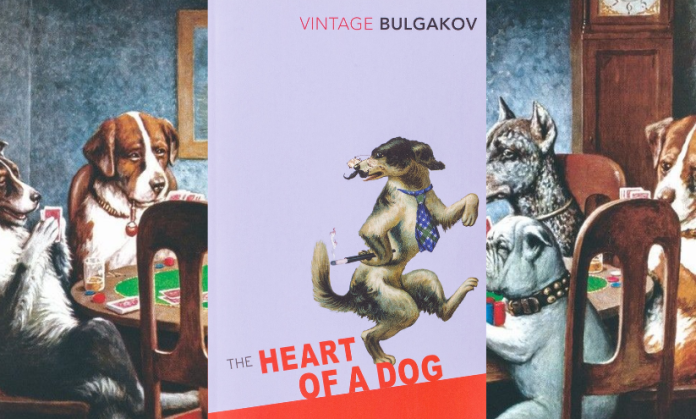“Ooow-ow-ooow-owow! Oh, look at me, I’m dying.”
Written in 1925, Heart of a Dog is a masterpiece of early modernist literature, in which science fiction and dystopian elements are expertly combined with Mikhail Bulgakov’s razor-sharp satirical wit. Heart of a Dog is a satire on Bolshevism and a scathing indictment of eugenics. Additionally, it is widely interpreted by academics as an allegory of the Communist revolution’s attempt to transform humanity.
Heart of a Dog tells the story of a stray mongrel named Sharik, who, although close to death, is taken in by the preeminent surgeon, Filipp Filippovich Preobrazhensky. Preobrazhensky’s intentions are, however, not wholly altruistic as although initially pampered, Sharik later undergoes extensive and experimental surgery at the hands of Preobrazhensky and his protégé Ivan Arnoldovich Bormenthal. During the operation, Sharik is given human organs (specifically a pituitary gland and testicles).
Over the following weeks, Sharik begins to transform into a brutish, mannerless, primitive man with a penchant for vodka. Following his transformation, Sharik torments Preobrazhensky, leading to the novella’s outlandish conclusion.
The key thematic element of the artificial creation of life in Heart of a Dog is, in a way, incredibly reminiscent of Mary Shelley’s seminal literary work, Frankenstein; or, The Modern Prometheus (1818). Both works feature a creature embued with life at the hands of a great, but flawed man; both creatures are conceived with a combination of human and animal parts — Victor’s Creature is mostly human, Preobrazhensky’s, mostly dog. Furthermore, both creatures eventually cause their creator a great deal of pain; like Victor’s Creature in Frankenstein, Sharik proceeds to make his Creator’s life a living hell (albeit with a lot less murder).
The novella is a thinly veiled scathing critiquing the Communist Revolution and its attempt to transform mankind. Although Sharik is transformed into a primitive man, he retains the manners and actions of a dog, acting in a slatternly and egoïstic way, representing the archetype of the New Soviet Man. Like many Russian artistic works created during the Soviet period, Heart of a Dog was heavily censored by the government and not officially published in Russia until 1987, more than 60 years after its completion.
Like his other widely beloved novel, The Master and Margarita, Bulgakov’s Heart of a Dog has deservedly earned a place in the canon of Russian literature. For those who enjoy Bulgakov’s other prose works, or the literature of Kafka, Gogol, or Camus, Heart of a Dog is a novella that will be hard to put down (excuse my pun).
“Slicing, examining, he frowned and sang: ‘To the banks of the sacred Nile . . .’”
This review of Heart of a Dog by Mikhail Bulgakov is the twelfth instalment of a fortnightly series called 50 Books. The series shines a spotlight on classical literature from throughout history and all over the world. If you have suggestions for future instalments comment and let me know.
Next time: Lady Caroline Lamb’s debut novel, Glenarvon.
Words by Luke Horwitz
Want more Books content from The Indiependent? Click here!
Support The Indiependent
We’re trying to raise £200 a month to help cover our operational costs. This includes our ‘Writer of the Month’ awards, where we recognise the amazing work produced by our contributor team. If you’ve enjoyed reading our site, we’d really appreciate it if you could donate to The Indiependent. Whether you can give £1 or £10, you’d be making a huge difference to our small team.
